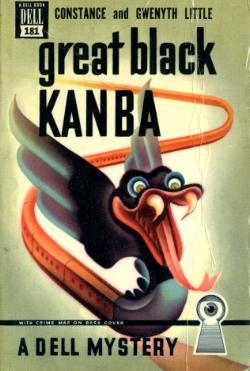Book Review: Great Black Kanba by Constance and Gwenyth Little
A young woman wakes up on a train with no memory of who she is or how she got there. According to Mrs. Bunton, the lady tending her, the woman is Cleo Ballister, an American actress on the skids who’s come to see her Australian relatives. Mrs. Bunton abandons Cleo on the platform and our heroine meets the Ballisters. And her fiance, Dr. Clive Butler.

The Ballisters are an interesting lot. Uncle Joe, a roistering fellow with poor grammar, has the family money. His widowed sister in law Aunt Esther is the prim and proper type. Her son Wilfred is pink and plump, and told what to do by his wife Mary. Their twelve year old daughter Eileen takes after her grandmother in strength of personality, but is much more friendly. And then there’s distant cousin Jimmy, who insists that it is he who is Cleo’s fiance.
They’re all off on a transcontinental rail trip to the other side of Australia, where Uncle Jo e lives. As Cleo tries to unravel what’s real and what’s not, murder lurks in the train corridors!
The Little sisters were known for somewhat humorous mysteries, usually with the words “black” or “gray” in the title. In this case, the title refers to a kind of legendary giant snake of Aboriginal lore, which they nicknamed the steam engine trains after. The book was published in 1944, but clearly set before 1941, as World War Two would have made very noticeable changes in the story.
Cleo tries to hide her amnesia at first, helped along by the fact she’s supposedly never met most of these people, thus she can ask questions as a naive newcomer. But as bits and pieces come back, she realizes her past doesn’t add up. Her clothing is far too gaudy for her personality, Clive and Jimmy’s claims of engagement don’t match, and she’s pretty sure she’s never been an actress.
To be honest, the mystery aspect of the story is a bit tedious, and what really fascinated me was the details of Australian rail travel in the late 1930s. It’s also almost Christmas, and the blazing heat in December discombobulates our heroine, which is a nice touch. Australian aborigines are seen at a distance, but play no actual part, and racism doesn’t really come in.
While Cleo isn’t a very good detective, she does manage to piece together the truth just before the police do (it’s not that the police are stupid in this one, it’s more that they need actual evidence.)
Most of the characters are fun to read about, but the romantic banter between Cleo and Clive is a bit forced. (Cousin Jimmy is not one for the sweet talk approach to romance.)
Recommended to fans of Thirties-style murder mysteries with comedic touches, and highly recommended to rail fans.

